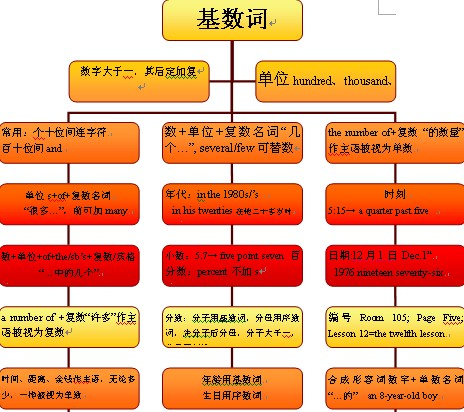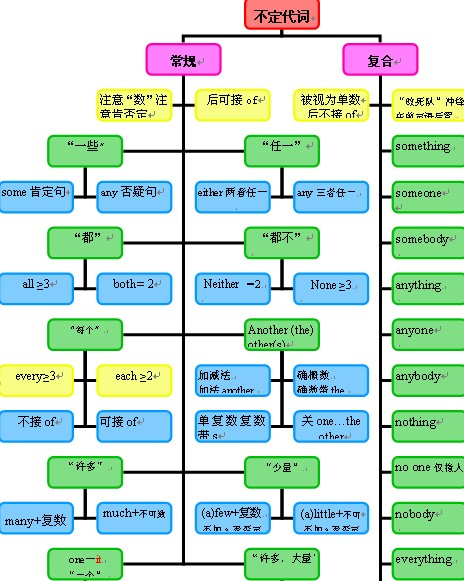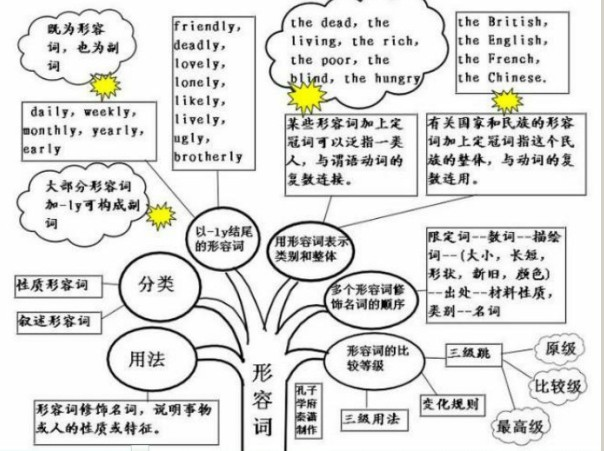基数词的概念:
数词是指表示数目多少或顺序先后的词。表示数目多少的数词叫基数词,如one, five, ten, thirty, sixty-five等,数词与不定代词用法相似,在现代英语中,它与不定代词、冠词、指示代词、形容词性物主代词等被称之为限定词。数词用法相当于名词和形容词,在句中可用作主语、宾语、表语、定语、同位语等。
时刻的表示法:
①若为整点钟,则直接读相应的基数词;若为非整点钟,则分别以“时”和“分”为单位用相应的基数词读出:
如:twelve (12),
eight twenty (8:20),
nine forty-five (9:45)
②对于带“分”的时间,也可借助past(过)和to(差)这两个介词来表示(在美国英语中用after表示“过”)。
注:这样表示时“分”不能超过30,否则应作处理,如9.38应处理成“10点差22分”:
如:9.18 eighteen minutes past(after)nine(=nine eighteen)
10.46 fourteen minutes to eleven(=ten forty-six)
以上分钟后带了minutes一词。若“分”为5,10,15,20等五的倍数,则可省略minutes:
如:8.05 five(minutes)past[after]eight(=eight five)
9.20 twenty(minutes)past[after]nine(=nine twenty) 若“分”为15或45,可借用quarter一词;若“分”为30,可借用half一词:
如:6.15 a quarter past six
8.45 a quarter to nine
10.30 half past ten
注:时刻表示法分为12小时编时制和24小时编时制。
日期的表示法:
日期的写法(书面语)和读法(口语)稍有不同,如“十月一日”可以写成October1, October 1st, 1October, 1st October, (the)1st of October 等,表示月份的词也可用缩略式,如Oct.1, 1Oct.1,但是在口语中通常只有两种读法October(the)first或the first of October。
注:日期与星期排列时,通常是星期在前,日期在后:
如:He arrived on Friday, May10. 他于5月10日(星期五)到达。
年份的表示法:
通常以“百”为单位来读。如1986年通常读作nineteen(hundredand)eighty-six,除非在正式场合,其中的hundred and通常都省,但在通常情况下不能按普通基数词的读法那样读成one thousand nine hundred and eighty-six。不过,像1500这样的年份可以有两种读法one thousand five hundred和fifteen hundred,而2000年通常读作two thousand,2003年读作two thousand and three。若表示某个某个年代,则按类似以下的读法:1980s读作nineteen-eighties(20世纪80年代),1600s读作sixteen hundreds(17世纪头10年,即1600—1610),比较:1300 thirteen hundred(1300年)。
基数词的表示法:
(1)以下是最基本的基数词:
one(1), two(2), three(3), four(4), five(5), six(6), seven(7), eight(8), nine(9), ten(10),
eleven(11), twelve(12),thirteen(13), fourteen(14), fifteen(15), sixteen(16), seventeen(17), eighteen(18), nineteen(19),
twenty(20), thirty(30), forty(40), fifty(50), sixty(60), seventy(70), eighty(80), ninety(90), a hundred(100), a thousand(1000), a million(1000000), a billion(十亿)
(2)21—99的表示法。先说“几十”,再说“几”,中间加连字号:
如:twenty-one(21),
thirty-six(36),
forty-five(45),
ninety-nine(99)等。
(3)101—999的表示法。先说“几百”,后接and,再加末尾两位数(或末位数):
如:one hundred and one(101),
five hundred and thirty(530),
seventy hundred and eighty-nine(789)
(4)1000以上的基数词的表示法。先从右至左数,每三位数加一个逗号(即以此把数目分为若干段)。
第一个逗号前的数为thousand(千),第二个逗号前的数million(百万),第三个逗号前的数为billion(十亿),第四个逗号前的数为trillion(万亿),然后一段一段地数:
如:9,883 nine thousand, eigh thundred and eighty-three
65,359 sixty-five thousand, three hundred and fifty-nine
265,468 two hundred and sixty-five thousand, four hundred and sixty-eight
60,263,150 sixty million, two hundred and sixty-three thousand,one hundred and fifty
注:①英语没有“万”这个单位,要表示“万”须借用thousand,如“一万”用“十千”表示(ten thousand),“十万”用“百千”表示(one hundred thousand)。
②hundred, thousand, million, billion等词在读数时不带复数词尾-s(即用单数形式)。
③在hundred后通常加上连词,不过此and在美国英语中可以省略。若读数中没有hundred,则在thousand后加and。
④一个数的最高位若为“一”,这个“一”可用a或one表示,但在数字中间的“一”,则只能用one,不能用a:
如:1600a[one]thousand and six hundred
6100 six thousand and one hundred (其中的one不可改为a)
⑤在非正式场合,人们也常以hundred为单位来读数
如:It cost fifteen hundred pounds. 这东西花了1500英镑。
基数词知识体系:

用于复数形式的基数词:
(1)表示整十的基数词用复数形式可以表示人的岁数或年代:
如:in the sixties 在60年代
in one's thirties 在某人30多岁时
(2)基数词转化为名词,可用复数形式:
如:How many twos are there in ten? 10里面有几个2?
Thesoldiersmarchedintens.士兵们10人一排前进。
(3)某些习语中也用复数形式的基数词:
如:in[by] twos and threes 三三两两地
at sixes and sevens 乱其八糟
表示倍数的基数词:
1、倍数+as+形容词/副词(原级)+as+比较对象。
如:这座桥是那座桥的三倍长。
Thisbridgeisthreetimesaslongasthatone.
2.倍数+形容词或副词的比较级+than+比较对象。
如:这座桥是那座桥的三倍长。
Thisbridgeisthreetimeslongerthanthatone.
3.倍数+thesize/length/weight…+of+表示比较对象的名词。
如:这座桥是那座桥的三倍长。
Thisbridgeisthreetimesthelengthofthatone.
相关高中英语知识点:不定冠词
不定冠词的概念:
冠词是置于名词前,说明各词所表示的人或事物的一种虚词,它不能离开名词而单独存在。冠词有两种,一种是定冠词,一种是不定冠词。定冠词是the,不定冠词有两种形式,一是a,另一是an。不定冠词a用于辅音音素起首的单词前,an用于元音音素起首的单词前。如:a bike, a dog, an egg, an elephant
不定冠词的特殊用法:
(1)用于序数词之前,表示数量或序数的增加:
如:Soon I saw a second plane.不久我又看到了另一架飞机。
"This is the second time that I've read the book."“这是我第二次看这本书。”
"Do you want to read it a third time?"“你还想看第三次吗?”
(2)用于表示“非常”、“很”等意义的most前:
如:This is a most interesting story. 这是一个非常有趣的故事。
(3)用于物质名词前,使之转化为具体名词,表示“一种”、“一杯之量”等:
如:A coffee, please. 请给我来杯咖啡。
I'd like a tea, please. 我要来杯茶。
(4)用于抽象名词前,使之具体化,表示与该之相关的具体的人或事:
如:He was a success in business. 他事业成功。
It's a pleasure to talk with you. 同你谈话是件令人愉快的事。
(5)用于指人的专有名词前,指某人、某人的作品或艺术品、…似(式)的人等:
如:A Mr Smith wants to see you. 一位名叫史密斯先生的人想见你。
He bought a complete Lu Hsun. 他买了一套鲁迅全集。
He thought he was a Zhu Geliang. 他自以为是诸葛亮。
(6)用于某些由动词转化来或具有动作意味的名词前,表示一次、一番等义(通常与have,take,make,give等动词连用):
如:Let's go out for a walk. 我们出去走走吧。
如:Do you care for as moke? 抽烟吗?
Would you like a drink? 要喝一杯吗?
(7)有的不可数名词或本来带有定冠词the的名词,由于受定语的修饰,其前可用不定冠词,表示某种状态。此时的不定冠词含有类似akindof的意思:
如:have breakfast 吃早餐─have a quick breakfast 吃快餐
the world 世界─a world like ours 像我们这样的世界
(8)构成短语表示数量:
如:a few apples 几个苹果
a little money 一点点钱
a lot of time 许多时间
a great many friends 许多朋友
不定冠词与one的用法解析:
1、两者均可表示“一”的意思,有时可互换。
如:About a[one] thousand students attended the meeting. 大约有1000学生参加了会议。
注:在数字开头时,两者均可用;但若不是数字开头,则应用one,如不可说three thousand a hundred,而说three thousand one hundred
如:A [One]Mr Smith wants to see you. 一个名叫史密斯先生的人想见你。(a Mr...与one Mr...同义,也可说a certain Mr...,但如果没有Mr这样的词,两者则不宜随便互换,否则含意会发生变化。
2、尽管两者均可表示“一”,有时也可换用,但毕竟由于两者的词性不同,用法不同,在多数情况下是不能互换的:
(1)从词性上看:a(an)是不定冠词,主要表示类别,即着重表示其后的名词是某物,而不是其他物;而one表示“一(个)”时是数词,主要表示数量,即强调在数量上是一个,而不是两个或多个。
比较:Give me a dictionary. 给我一本字典。
Give me one dictionary. 给我一本字典。
前者强调的是,我要的是一本字典,而不是一本教材,也不是一本小说等;而后者强调的是,我要的是一本字典,而不是两本字典或多本字典)。
再比较以下一组表达在意义上的区别:
more than a year一年多 (如一年零三个月等)
more than one year 不止一年 (如两年或三年等)
(2)由于one是数词,着重数量意义,所以当要强调数量、进行数量对比或回答how many的提问时,均应用one,而不能用a(an)。
如:He has only one pen, but I have two. 他只有一枝钢笔,但我有两枝。
I want one box, not five. 我想要一个盒子,不是要五个。
—How many friends do you have here? 你在这儿有多少个朋友?
—Only one.只有一个。
(3)在某些表达中,两者均可用,但含义不同:at a time 每次,同时 at one time 一度,曾经 as a man 就一个人的性格而论 as one man一起,同时,全体一致地
在某些表达中,两者均可用,虽含义相同,但表达不同:
on a hot summe rafternoon 一个炎热的夏日的下午(注意用介词on)
one hot summer afternoon 一个炎热的夏日的下午(注意不用介词on)
an hour and a half一个半小时(通常不说one hour and a half)
one and a half hours 一个半小时
a minute or two一两分钟(通常不说one minute or two)
one or two minutes 一两分种
在绝大多数习语中,两者是不能换用的。如:
in a hurry 匆忙 once up on a time 从前 as a result 结果 all of a sudden突然 oneday 一天
one by one一个一个地 one and all 全部,每个人one and the same 完全相同的
英语不定冠词(a/an)的用法:
1、用a还是an:一般说来,辅音或半元音[j, w]开头的词要前用a。
如:He has a computer (watch). 他有一台电脑(一块手表)。
He's a university student (European). 他是大学生(欧洲人)。
元音开头的词前要用an。
如:This is an egg (hones tboy). 这是一只鸡蛋(诚实的男孩)。
注意:有的字母(如a,e,f,h,i等) 或缩略词,若第一个音是元音也应用an。
如:He missed an "n" in the word. 他写的这个单词漏了一个n。
2、不要从汉语习惯出发,漏掉必用的a/an。
如:他父亲是著名诗人。
误:His father is famous poet.
正:His father is a famous poet.
3、用于转化为普通名词的专有名词前,表示某某人或某某人的一部作品、艺术品等。
如:A Mr Smith wants to see you. 一位叫史密斯先生的人想见你。
He bought a complete Lu Hsun. 他买了一套鲁迅全集。
4、用于转化为普通名词的物质名词前,表示相应的产品或种类,有时表示数量关系。
如:It’sagoodwine.这是(一种)好酒。 Twocoffeesandatea,please.请来两杯咖啡和一杯茶。
5、用于具体化的抽象名词前,表示与该抽象名词意义相关的人或事等。
如:The party was a great success. 晚会开得非常成功。
It's a pleasure to talk with you. 同你谈话是件愉快的事。
6、用于某些由动词转化来或具有动作意味的名词前,表示一次、一番等意义。
如:Let me have a look. 让我看看吧。
I'll give the car a good wash. 我要把车好好洗一洗。
7、用于序数词前表示数量或序数的增加。
如:He bought a second computer. 他又买了一台(即第二台)电脑。
Later she borne a third son. 后来她又生了第三个儿子。
8、有的不可数名词或本来应该带定冠词(the)的名词,由于受定语(尤其是形容词)的修饰,其前一般要用不定冠词或改用不定冠词,表示某种状态,此时的不定冠词通常含有a kind of的意思。
如:have breakfast 吃早餐→have a quick breakfast 吃快餐
the world 世界→a world like ours 像我们这样的世界
注:有些不可数名词即使受形容词的修饰也不能用不定冠词,容易弄错的有:news(消息),advice(忠告),luck(运气),fortune(运气),work(工作),fun(娱乐,有趣的事),weather(天气),homework(家庭作业),housework(家务活),information(情报),behavior(行为),harm(伤害),damage(损害),progress(进步),furniture(家具),baggage(行李),luggage(行李),poetry(诗),scenery(风景)等。
9、两个单数可数名词连用表示一个整体时,只用一个不定冠词。
如:He is a teacher and poet. 他既是老师又是诗人。
There's a horse and cart on the road. 路上有一辆马车。
10、不定冠词可用来表示“类属”,这是其基本用法,它表明的是某一类属中的每一个人和东西都能说明该类属的整体情况(有类似汉语的“举一反三”或“以此类推”的含义)。此时也可用定冠词或名词复数形式来表示。
如:马是有用的动物。
正:A horse is a useful animal.
正:The horse is a useful animal.
正:Horses are useful animals.
若不是说明每一个人和东西的情况,而是说整个类属,则不能用不定冠词,而要用定冠词。
如:The tiger is indanger of becoming extinct.老虎面临绝种的危险。
Alexander Graham Bell invented the telephone in 1876.亚历山大·格雷汉母·贝尔于1876年发明了电话。
不定冠词知识体系:
| 不定冠词 | a | 1、辅音音素开头的单词前用a,否则用an。 2、泛指,表“一个”但概念比one弱。 3、表类别 a+可数名词单数,不译为“一”。 4、表示单位,相当于“每”的意思。 5、用于序数词前,表“又一,再一”。 6、用于某些固定词组中,a lot of等。 |
| an |
使用不定冠词和不用不定冠词的差异:
1、英语中的某些名词即可用作不可数名词,又可用作可数名词,但是含义不同,用法也不一样。
如:iron 铁;an iron 一个熨斗
kindness 和善; a kindness 一件善事
2、“with+抽象名词”使用时相当于副词,抽象名词前不用不定冠词。
如:with pleasure 乐意地
with kindness 亲切地
with joy 高兴地
with diffculty 吃力地
with angry生气地
但在“with+a+名词”结构中虽有不定冠词,却没有实际意义。
如:with a smile 微笑地
with an effort 努力地
with a light heart 愉快地
因汉语习惯用错不定冠词的几种情形:
(1)单数可数名词若泛指,其前需加a/an,不要按汉语习惯漏掉此不定冠词:
如:他是著名影星。
正:Heisafamousfilmstar.
误:Heisfamousfilmstar.
(2)不定冠词不能与指示代词、物主代词、所有格等连用:
如:我在公园遇到了我的一位朋友。
正:Imetafriendofmineinthepark.
误:Imetmyafriendinthepark.
(3)不要受汉语影响而用错不定冠词位置:
如:我从未读过如此有趣的书。
正:Ihaveneverreadsuchaninterestingbook.
误:Ihaveneverreadasuchinterestingbook.
误:Ihaveneverreadasointerestingbook.
不定冠词的省略与重复:
(1)在不引起误会的情况下,两个并列名词中的后一个名词前的不定冠词可以省略:
如:The noun is the name of a person or thing. 名词是人和物的名称。
(2)当两个并列名词指的是同一个人时,后一名词前的不定冠词通常省略:
如:His father is a teacher and poet. 他父亲是位教师兼诗人。
但如果要强调这两种身份,也可后一个不定冠词:
His father is a teacher and a poet. 他父亲既是教师,又是诗人。
有时,由于两个并列的名词关系比较紧密、被视为一个整体,也可只用一个冠词:
A man and woman are walking arm-in-arm.一对男女手挽着手走着。
(3)两个形容词并列同时修饰一个名词时,若该名词指的是两个事物,则通常应分别使用两个冠词:
如:We have a black and a white cat. 我们养了一只黑猫和一只白猫。
(比较:We have a black and white cat. 我们养了一只黑白花猫。)
但是,有时两个并列的名词只一个事物,为了加强语气,也有了两个冠词:
如:It was a cold and a dark night. 那是一个又冷又黑的夜晚。
(4)有些由两样东西构成的“自然成对”使用的事物,通常只在其前使用一个冠词:
如:a knife and fork一副刀叉
a cup and saucer 一副茶杯与茶托
a horse and cart 一辆马车
a needle and thread 一根带线的针
hire a car and driver 租一辆配有司机的汽车
有时连第一个冠词也省略(尤其是与介词连用时):
如:with knife and fork 用刀叉
(5)当要对两个并列的名词进行选择和比较方面的强调时,通常应重复两个冠词:
如:Give me a pen, not a pencil. 给我一支钢笔,不是铅笔。
Do you want a novel or a dictionary? 你是想要本小说,还是想要本字典?
相关高中英语知识点:不定代词
不定代词概说:
英语的不定代词有all, each, both, either, neither, one, none, little, few, many, much, other, another, some, any, no, few, little, both, enough, every等,以及由some,any,no和every构成的合成代词(即somebody, anyone, nothing等)。在这些不定代词中,多数都能作主语、宾语、表语或定语,但是代词none以及由some, any, no和every构成的合成代词只能作主语、宾语或表语,不能作定语,而no和every则只用作定语。
不定代词用法对比:
1、so little与such little的区别:
用so little还是such little取决于little的意思:若表示数量方面的“少”,则用so little;若表示形状体积的“小”,则用such little:
如:He has so little time for reading. 他读书的时间少得可怜。
I've never seen such little boxes. 我从未见过那样小的盒子。
2、some与any的用法区别:
一般说来,some用于肯定句中,any用于否定句和疑问句中。但是,在表示请求、邀请或征求意见的句子中,通常要用some而不用any:
如:Would you like some cake? 吃点蛋糕吗?
Why not buy some bread? 为什么不买些面包呢?
Shall I get some chalk for you? 要我帮你拿些粉笔来吗?
注:any有时也用于肯定句中,此时表示“任何”:
如:Any colour will do. 任何颜色都行。
Come any day you like. 随便哪天来都可以。
3、many与much的用法区别:
两者都表示“许多”,但many修饰或代替可数名词(复数),与few(少数)相对;
而much用来修饰或代替不可数名词(单数),与little(少量)相对。在口语中两者主要用于非肯定句中:
如:Did you see many people there? 你在那儿看见许多人了吗?
We don't have much time. 我们没有许多时间。
在肯定句中,一般用a lot of, lots of, plenty of 等代之。但在正式文体中有时也用于肯定句中;
另外,若用作主语或主语的定语,或其前有how, too, as, so, a good, a great等修饰,也可用于肯定句中:
如:Many of us left early. 我们有许多人离开得很早。
Much work has been done. 许多工作都已经做了。
You've given me too much. 你已给我太多了。
Take as many(much) as you want. 你要多少拿多少。
I asked her a great many questions. 我问了她许多问题。
4、few, a few与little, a little的用法区别:
(1)few和a few后接可数名词的复数形式。few表示数量很少或几乎没有,强调“少”,含有否定意义;
a few表示数量虽然少但毕竟还有,强调“有”,含有肯定意义:
如:It is very difficult, and few people understand it. 它很难,没有几个人能懂。
It is very difficult, but a few people understand it. 他虽难,但是有些人懂。
(2)little和alittle之后接不可数名词,其区别跟few和a few之间的区别相似:
如:Unfortunately, I had little money on me. 很不巧,我身上没带什么钱。
Fortunately, I had a little money on me. 幸好我身上带着一点钱。
5、other, the other, another与others的用法区别:
这些不定代词不仅在含义上有单复数之分,而且在用法上有泛指(无the)和特指(有the)之别。其用法区别可归纳如下:
(1)指单数时,若泛指用another,若特指用the other:
如:Give me another(one). 另外给我一个。
Shut the other eye, please. 请把另一只眼睛也闭上。
(2)指复数时,若泛指用other(后接复数名词),若特指用the other(后接复数名词):
如:There are other ways of doing it. 做这事还有其他的办法。
Where have the other students gone? 其他学生都到哪里去了?
(3)others永远表示复数意义(且其后不能再接名词)。其用法大致相当于“other+复数名词”,同样地the others大致相当于“the other+复数名词”:
如:Other people[Others] may not think that way. 别的人可能不这样想。
He is cleverer than the others[the other students] in her class. 他比班上其他学生聪明。
(4)another一般只能表单数,且其后接名词也只能接单数名词。但是若其后有数词或few修饰时,则也可接复数名词:
如:We need another few chairs. 我们还需要几把椅子。
In another two weeks it'll be finished. 再过两个星期就可做完了。
(5)与some对比使用时,用others(此时与some同义):
如:Some say yes, and others say no. 有人说对,有人说不对。
不定代词用法点拨:
1、指两者和三者的不定代词:
有些不定代词用于指两者(如both, either, neither),有的不定代词用于指三者(如all, any, none, every),注意不要弄混:
如:Both of my parents are doctors. 我的父母都是医生。
All of the students are interested in it. 所有的学生对此都很感兴趣。
There are trees on any side of the square. 广场的每一边都种有树。
He has two sons, neither of whom is rich. 他有两个儿子,都不富有。
He has three sons, none of whom is rich. 他有三个儿子,都不富有。
注:each可用于两者、三者或三者以上,而every只用于三者或三者以上,因此用于两者时只能用each,不能用every。
2、复合不定代词的用法特点:
复合不定代词包括something, somebody, someone, anything, anybody, anyone, nothing, nobody, noone, everything, everybody, everyone等。它们在句中可用作主语、宾语或表语,但不能用作定语。something, someone等和anything, anyone等的区别与some和any的区别一样,前者一般用于肯定句,后者一般用于否定句、疑问句或条件句。具体使用时应注意以下几点:
(1)复合不定代词受定语修饰时,定语应放在它们后面:
如:There is nothing wrong with the radio. 这收音机没有毛病。
Have you seen anyone[anybody] famous? 你见过名人吗?
(2)指人的复合不定代词若用作主语,其谓语动词一般用单数,相应的人称代词和物主代词也用单数he, him, his(不一定指男性)。但在非正式文体中常用复数代词they, them, their:
如:Everyone knows this, doesn't he[don't they]? 人人都知道这一点,不是吗?
If anybody[anyone] comes, ask him[them] to wait. 要是有人来,让他等着。
(3)指事物的复合不定代词若用作主语,谓语动词只能用单数,相应的人称代词也只能用it,而不用they:
如:Everything is ready, isn't it? 一切都准备好了,是吗?
(4)anyone, everyone等只能指人,不能指物,且其后一般不接of 短语。若是指物或后接of 短语,可用any one, every one(分开写):
如:any one of the boys(books) 孩子们(书)当中的任何一个(本)
every one of the students(schools) 每一个学生(一所学校)
3、是any not还是not any:
按英语习惯,any以及含有any的复合不定代词用于否定句时,它只能出现在否定词之后,而不能在否定词之前:
误:Anyone doesn't know how to do it.
正:No one knows how to do it.任何人都不知道如何做它。
误:Anybody[Anyone] can not do it.
正:Nobody[Noone] can do it.这事谁也干不了。
误:Anything can not prevent me from going.
正:Nothing can prevent me from going. 什么也不能阻挡我去。
4、不定代词与部分否定:
不定代词all, both, every等与not连用时构成部分否定;若要表示完全否定,则需换用none, neither, no one等。
比较:All of the students like the novel. 所有这些学生都喜欢这本小说。
Not all of the students like the novel. 并不是所有这些学生都喜欢这本小说。
All of the students don't like thenovel. 并不是所有这些学生都喜欢这本小说。
None of the students like the novel. 这些学生当中没有一个喜欢这本小说。
5、all, both, each等用作同位语:
若用作主语同位语,主语可以是名词或代词;若用作宾语等其他成分的同位语,则宾语等成分必须是人称代词,而不能是名词:
如:We have all read it. 我们都读过他。(all修饰的主语是代词)
The villages have all been destroyed. 村庄都被毁了。(all修饰的主语是名词)
They told us all to wait there. 他叫我们都在那儿等。(all修饰的宾语是代词)
但不能说:They told the men all to wait there. (all修饰的宾语是名词不是代词)
不定代词知识体系:

不定代词与语境考题:
不定代词是高考的常考考点,有的不定代词考题出得比较灵活,不能死套规则,要注意结合语境来理解:
例1:—Is____here?
—No, Bob and Tim have asked for leave.
A. anybody
B. everybody
C. somebody
D. nobody
解析:
若只是从表面来看,填空句是个疑问句,可能会误选A。但其实此题最佳答案应选B,因为下文的答句说“只有Bob和Tim请假了”,这说明问句是在查人数,故用Is everybody here? (大家都到齐了吗?)
例2:I agree with most of what you said, but I don't agree with_____.
A. everything
B. anything
C. something
D. nothing
解析:
此句若从表面看,有可能误选B,因为填空句为否定句。但实际上最佳答案为A,因为上文说“我同意他说的大部分内容”,这与下文的but I don't agree with everything (但并不是同意他说的所有内容)完全相符。
例3:—Doyouhave_____athomenow,Mary?
—No, we still have to get some fruit and tea.
A. something
B. anything
C. everything
D. nothing
解析:答案:C,句意为“玛丽,现在家里东西都准备齐了吗?”“还没有,我们还要买些水果和茶。”
例4:—If you want a necklace, I'll buy one for you at once.
—Oh, no. A necklace is not_____that I need most.
A. anything
B. something
C. nothing
D. everything
解析:
此题容易误选A,机械地认为:something用于肯定句,anything用于否定句或疑问句。但是,此题的最佳答案是B,something在此的意思不是“某种东西”,而是指“那种东西”或“这种东西”,即心中最想要的那种东西(相当于the thing)。
相关高中英语知识点:形容词
形容词的概念:
形容词(adjective),简称adj.或a,形容词用来修饰名词或代词,表示人或事物的性质、状态,和特征的程度好坏与否,形容词在句中作定语、表语、宾语补足语。通常,可将形容词分成性质形容词和叙述形容词两类,其位置不一定都放在名词前面。
形容词的作用与位置:
形容词是用来修饰名词的,常被放在名词前作定语,或放在系动词后面作表语。以下属几种特殊情况,须牢记;
(1)形容词短语作定语,定语后置。
如:a language difficult to master,
a leaning tower about 180 feet high
(2)表语形容词(afraid、alike、alone、asleep、awake、alive等)作定语,定语后置。如a man alive。有些表身体健康状况的形容词如well、faint、ill只作表语。sick既可作表语又可作定语,ill如作定语意为“bad”。
(3)用作定语,修饰由不定代词one、no、any、some和every构成的复合词如anything、something等时,通常后置。
如:I have something important to tell you.
(4)else常用作疑问代词和不定代词的后置定语。
(5)enough、nearby修饰名词前置或后置,程度副词一般位于形容词、副词前面,enough修饰形容词、副词时,必须后置。
(6)几个并列的形容词作定语,其语序通常为:限定语(The、A)+描绘性形容词+size(大小)+shape(形状)+age(年龄、时间)+color(颜色)+origin(国籍、来源)+material(材料)+purpose(目的)+名词。
口诀:
限定描绘大长高,形状年龄和新老;颜色国籍跟材料,作用类别往后靠。
如:a heavy black Chinese steel umbrella,
the man's first tow interesting little red French oil paintings
形容词的用法:
1、形容词修饰名词,说明事物或人的性质或特征。通常,可将形容词分成性质形容词和叙述形容词两类,其位置不一定都放在名词前面:
1)直接说明事物的性质或特征的形容词是性质形容词,它有级的变化,可以用程度副词修饰,在句中可作定语、表语和补语。例如:hot热的。
2)叙述形容词只能作表语,所以又称为表语形容词。这类形容词没有级的变化,也不可用程度副词修饰。
大多数以a开头的形容词都属于这一类。例如:
afraid害怕的。(错)Heisanillman. (对)Themanisill. (错)Sheisanafraidgirl. (对)Thegirlisafraid.
这类词还有:well,unwell,ill,faint,afraid,alike,alive,alone,asleep,awake等。
3)形容词作定语修饰名词时,要放在名词的前边。但是如果形容词修饰以-thing为字尾的词语时,要放在这些词之后。例如:somethingnice
2、用形容词表示类别和整体:
1)某些形容词加上定冠词可以泛指一类人,与谓语动词的复数连接。如:the dead,the living,the rich,the poor,the blind,the hungry The poorarelosinghope.穷人失去了希望。
2)有关国家和民族的形容词加上定冠词指这个民族的整体,与动词的复数连用。如:the British,the English,the French,the Chinese. The English have wonderful senseofhumor.
以-ly结尾的形容词:
1)大部分形容词加-ly可构成副词。但friendly,deadly,lovely,lonely,likely,lively,ugly,brotherly,仍为形容词。改错:
如:(错)She sang lovely.
(错)He spoke to me very friendly.
(对)Her singing was lovely.
(对)He spoke to me in a very friendly way.
2)有些以-ly结尾既为形容词,也为副词。 daily,weekly,monthly,yearly,early .
如:The Times is a daily paper.
The Times is published daily.
形容词知识体系:

复合形容词的构成:
(1)形容词+名词+ed:
如:kind-hearted 好心的,white-haired 白发的
(2)形容词+形容词:
如:red-hot 炽热的,dark-blue 深蓝的
(3)形容词+现在分词:
如:good-looking 好看的,easy-going 随和的
(4)副词+现在分词:
如:hard-working 勤劳的,fast-moving 快速转动的
(5)副词+过去分词:
如:hard-won 得来不易的,newly-made 新建的
(6)名词+形容词:
如:life-long 终生的,world-famous 世界闻名的
(7)名词+现在分词:
如:peace-loving 爱好和平的,fun-loving 爱开玩笑的
(8)名词+过去分词:
如:snow-covered 白雪覆盖的,hand-made 手工的
(9)数词+名词+ed:
如:four-storeyed 4层楼的,three-legged 3条腿的
(10)数词+名词(名词用单数):
如:ten-year 10年的, two-man 两人的
相关高中英语知识点:介词和介词短语
介词和介词短语的概念:
介词是一种用来表示词与词、词与句之间的关系的虚词,在句中不能单独作句子成分。介词后面一般有名词、代词或相当于名词的其他词类,短语或从句作它的宾语。介词和它的宾语构成介词词组,在句中作状语,表语,补语或介词宾语。介词可以分为时间介词、地点介词、方式介词和其他介词。
误用介词的三种情况:
1、多用介词:
多用介词可能是受汉语意思的影响将及物动词误用作不及物动词,也可能是受相关结构的影响而用错:
误:We discussed about the plan.
正:We discussed the plan. 我们讨论了计划。
误:Did he mention about the accident?
正:Did he mention the accident? 他提到那次事故了吗?
误:I saw her enter into the bank.
正:I saw her enter the bank. 我看见她进了银行。
误:He married with[to] a nurse.
正:He married a nurse. 他同一位护士结了婚。
误:How can contact with you?
正:How can contact you? 我怎么与你联系?
误:We should serve for the people heart and soul.
正:We should serve the people heart and soul. 我们应该全心全意地为人民服务。
误:Who controls over the factory? (但名词control可接over)
正:Who controls the factory? 谁管理这个工厂?
误:He has a great many of friends here. (比较a great number of)
正:He has a great many friends here. 他在这儿有很多朋友。
2、漏用介词:
漏用介词可能是受汉语意思的影响将不及物动词误用作及物动词,或是受相关结构的影响的影响而用错等:
误:This matter is difficult to deal. (deal with=处理)
正:This matter is difficult to deal with. 这事很难处理。
误:He is not a man to be depended.
正:He is not a man to be depended on. 他不是个可靠的人。
误:He took a cup of tea, and went on the story.
正:He took a cup of tea, and wentonwiththestory.他喝了一口茶,又接着讲故事。
误:My mother still regards me a child. (比较consider…as中的as可省略)
正:My mother still regards me as a child. 我母亲还把我当小孩看。
误:They insisted sending a car over to fetch us.
正:They insisted on sending a car over to fetch us.他们坚持要派车来接我们。
误:What he says is worth listening.
正:What he said is worth listening to.他的话值得一听。
3、错用介词:
错用介词的情况比较复杂,可能是因受汉语意思的而错,也可能是因弄不清搭配关系而错,可能是混淆用法而错,也可能是受相关结构的影响而错,可能是忽略语境而错,也可能是想当然的用错:
误:She called on his office yesterday. (call on+人,call at+地点)
正:She called at his office yesterday. 她昨天去了他办公室拜访。
误:He is engaged with a nurse.
正:He is engaged to a nurse.他与一位护士订了婚。
误:The sun rises from the east.
正:The sun rises in the east.太阳从东方升起。
误:Under his help, I finished it in time.
正:With his help, I finished it in time. 在他的帮助下,我及时做完了。
误:During he was in Japan, he visited many places.
正:During his stay in Japan, he visited many places.他在日本期间,参观过许多地方。
误:We are familiar to his character.
正:We are familiar with his character.我们了解他的性格。
误:Help yourself with the fruit.
正:Help yourself to the fruit.吃点水果吧。
介词的宾语:
1、名词或代词作介词宾语:
如:Are you interested in history? 你对历史感兴趣吗?
Don't worry about it. 别为它担心。
注:若是人称代词用作介词宾语,要注意用宾格。
如:No one can sing like her. 没有人能像她那样唱歌。(不能用like she)
2、动名词作介词宾语:
如:He is good at telling stories. 他善于讲故事。
In crossing the street he was run over. 他在穿过马路时被汽车撞倒。
3、过去分词作介词宾语:
如:We can't regard the matter as settled. 我们不能认为这事已经解决。
I take it for granted you have read the book. 我以为你读过这本书。
注:过去分词用作介词宾语通常只见于某些固定结构中,如上面第1句涉及regard…as(认为…是)结构,第2句涉及take sth for granted(认为某事属实)。在其他情况下,介词后通常不直接跟过去分词作宾语,若语义上需要接过去分词(表被动),可换用“being+过去分词”:
如:He went out without being seen by the others.他出去了,没有被其他人看见。
4、从句作介词宾语:
如:He was not satisfied with what she said. 他对她说的不满意。
I'm worried about where he is. 我担心他上哪儿去了。
注:介词后通常不接that从句,遇此情况需考虑用其他结构:
误:He paid no attention to that she was poor.
正:He paid no attention to the fact that she was poor. 他根本不注意她很穷这一事实。
但有个别介词(如except)可接that从句。
比较:I know nothing about him except that he lives next door./I know nothing about him except for the fact that he lives next door. 我只知道他住在隔壁,其它的就不知道了。
5、不定式作介词宾语:
如:I had no choice but to wait. 除了等,我没有别的选择。
He wanted nothing but to stay there. 他只想留在那儿。
They did nothing but complain. 他们老是一个劲地抱怨。
He never did anything but watch TV. 除了看电视,他从不干任何事。
注:(1)介词后接不定式的情形通常只见于but, except等极个别个词。该不定式有时带to,有时不带to,其区别是:若其前出现了动词do,其后的不定式通常不带to;
若其前没有出现动词do,则其后的不定式通常带to。
(2)介词后虽然通常不直接跟不定式作宾语,但却可接“连接代词(副词)+不定式”结构:
如:He gave me some advice on how to do it. 对于如何做这事他给我提了些建议。
6、形容词作介词宾语:
如:Her pronunciation is far from perfect. 她的语音远不是完美的。
In short, we must be prepared. 总而言之,我们要有准备。
Things have gone from bad to worse. 事情越来越糟。
注:(1)有些形容词用作介词宾语可视为其前省略了动名词being:
如:He regarded the situationas(being) serious. 他认为形势严重。
His work is far from(being) satisfactory. 他的工作丝毫不令人满意。
(2)有些“介词+形容词”的结构已构成固定搭配:in full全部地,全面地,无省略地; in private私下地,秘密地; in particular特别地;in general一般地,通常地,概括地; in brief 简言之;in short总之,简言之; in vain徒然地,徒劳无益地;for fee免费地,无偿地; for certain肯定地,确切地;for sure肯定地,确切地; for short为了简短,简称;atl arge自由自在地,逍遥法外; by far…得多
7、副词作介词宾语:
如:I can't stay for long. 我不能久呆。
It's too hot in here. 这里面太热了。
I looked every where except there. 除了那儿,我到处都看过了。
8、数词作介词宾语:
如:The city has a population of four million. 这座城市有四百万人口。
He was among the first to arrive. 他是第一批到的。
9、介词短语作介词宾语:
如:Choose a book from among these. 从这些书中选一本吧。
I saw her from across the street. 我从街的对面望见了她。
注:通常可后接介词短语作宾语的介词是from, till, until, since, except, instead of等。
比较:I took it from the bed. 我从床那儿(或床上)拿的。
I took it from under the bed. 我从床下拿的。
10、复合结构用作介词宾语:
如:She had no objection to Mary marrying him. 她不反对玛丽与他结婚。
She came in with a book in her hand. 她手里拿着一本书走了进来。
All the afternoon he worked with the door locked. 整个下午他都锁着门在房里工作。
介词短语的句法功能:
1、表语:
如:He was with a friend. 他和一个朋友在一起。
Health is above wealth. 健康胜过财富。
This knife is for cutting bread. 这把小刀是用于切面包的。
注:有些介词(如because of)引出的短语通常只用作状语,不用作表语:
误:His absence is because of the rain.
正:His absence is due to the rain. 他因雨未来。
但是,若主语是代词(不是名词),becauseof引出的短语可用作表语:
如:It is because of hard work. 那是因为辛苦工作的原因。
2、状语:
如:Don't touch it with your hands. 别用手去摸它。
Did you do this by design or by accident? 你这样做是有意的还是无意的?
3、定语:
如:This is his reply to your letter. 这是他给你的回信。
This is the best way of doing it. 这是做此事最好的方法。
My love for you is deeper than the sea. 我对你的爱比海深。
4、宾语补足语:
如:I found everythingin good condition. 我发现一切正常。
Her illness kept her in bed for a week. 她因生病在床上躺了一星期。
注:用作宾语补足语的介词短语在相应的被动语态中则为主语补足语:
如:He was regarded as a hero. 他被看成是英雄。
5、宾语:
如:A man stepped out from behind the wall. 一个人从墙后走出来。
He cannot spare anytime except on Sunday. 除星期日外,他抽不出时间。
6、主语:
如:Between6 and 7 suits me. 六点到七点对我比较适合。
After the exams is the time to relax. 考试后是轻松一下的时间。
注:介词短语通常不用作主语,尽管有时也像上面这样用作主语,但通常可视为是在一定的上下文中有所省略:
如:—When are we going to have the next meeting? 我们下次什么时候见面?
—On Tuesday may be convenient. 星期二可能比较方便。
此句中onTuesday虽用作主语,但可视为是其前省略了meeting一词:
即:Meeting during the vacation may be convenient.
本文来自:逍遥右脑记忆 http://www.jiyifa.com/gaozhong/262560.html
相关阅读:高中英语知识点:一般现在时的被动语态



